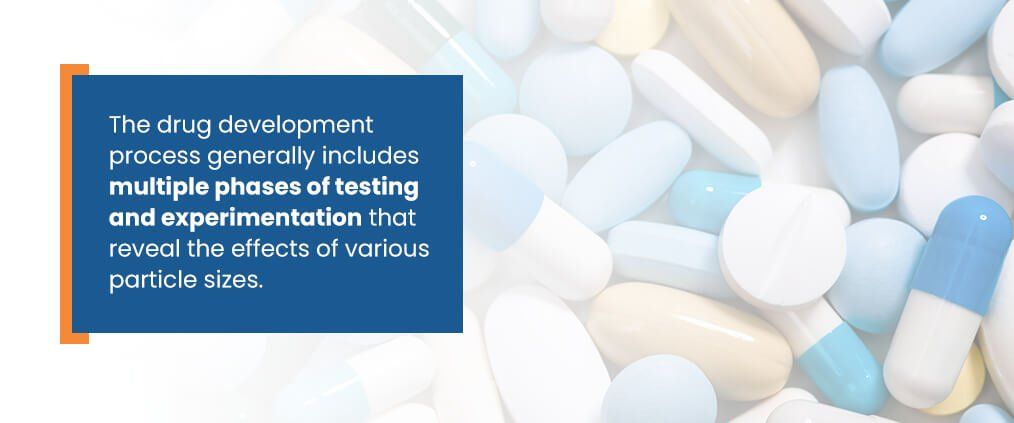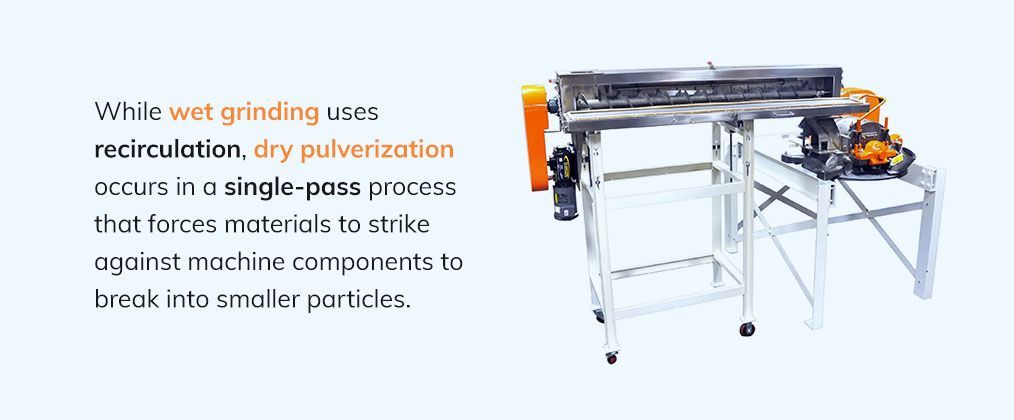Why Particle Size Distribution is Important for Pharmaceuticals

- What Is Pharmaceutical Particle Size Distribution?
- The Shape of the PSD Curve
- Why Is Particle Size Distribution Important for Pharmaceuticals?
- Why Is API Size Distribution Important for Drug Performance?
- Particle Size and Drug Manufacturability
- Best Pharmaceutical Particle Size Distribution Methods
- Particle Size Reduction Solutions From Pulva Corporation
PSD, or particle size distribution is important to determine as it affects drug efficacy, safety and manufacturability. Fortunately, having the right tools at your disposal makes achieving the correct particle size distribution quick and straightforward.
In the pharmaceutical industry, particle size distribution (PSD) is a measurement that describes the variation of particles in a drug according to their size. The importance of particle size in pharmaceutical development is evident through the various assessment paraments, for which PSD is the most significant. Measurement of PSD typically takes place with sieve analysis, laser diffraction, dynamic image analysis or dynamic light scattering.
The particles in a pharmaceutical product sometimes differ in measurement due to their shapes. For particles that are nearly perfectly spherical, their measurements use their diameter. Other ovoid or irregularly shaped particles might have both length and width measurements. While taking horizontal and vertical measurements provides the greatest accuracy, doing so is a more complex process than simply determining a diameter. Therefore, most measurements assume each particle is a sphere and report an approximate diameter only.
The particle diameters in pharmaceutical products typically form a bell curve distribution, where the x-axis records the particle size, and the y-axis records the frequency of occurrence. Most particle sizes fall in the middle of the diameter range, with only a few particles much larger or smaller.
The pharmaceutical industry uses three D-values to calculate the particle size distribution curve:
- D50: This value indicates the median particle size. 50% of the particle sizes fall below this value, and 50% fall above it.
- D10: 10% of the particles in the distribution are smaller than this value.
- D90: 90% of the particles in the distribution are smaller than this value.
The more closely grouped the three D-values are, the narrower the distribution curve will be. In general, a tight distribution curve is best because it means particle sizes are more uniform, though optimal distribution may vary for different drugs.
So why is particle size analysis and distribution so important so important in pharmaceutics? PSD can affect porosity and surface area. These properties, in turn, affect a new product's manufacturability, efficacy, quality, bioavailability and shelf life, making the importance of particle size distribution crucial for drug performance and ease of manufacturing. Off-spec particle sizes can impede production, lower yields and reduce profits, making accurate PSD milling crucial for pharmaceuticals.

The drug development process generally includes multiple phases of testing and experimentation that reveal the effects of various particle sizes. This data then informs the target PSD specifications for future manufacturing, and marks the importance of particle size determination. Achieving the correct PSD in this way helps ensure consistency and quality.
Some characteristics can make PSD an important factor in active pharmaceutical ingredient (API) absorption rates. The wrong particle size measurement can, for example, mean a drug's API does not reach the right part of the body at the correct rate and concentration.
It is particularly critical to ensure the correct particle size in inhaled drugs. If the particles are too large, they will lodge in the throat and enter the bloodstream through there. If the particles are too small, the patient will likely exhale them before the drug reaches the correct part of the lungs, negating the therapeutic effect.
Reducing particle size can also eliminate the need to take a drug with food. In drugs with adequate permeability but low solubility, larger particles can make prolonged contact with the membranes in the gastrointestinal system and irritate the stomach. Smaller particles' smaller surface area makes them less likely to irritate the stomach. In addition to being safer and more efficient, these drugs often lead to greater patient compliance and higher dose tolerances.
Not all drugs require particle size specifications. A particle size specification is usually only necessary if the particle size analysis of the drug in question is vital for its performance or manufacturability. While a highly soluble high-dose drug may not receive a particle size specification, a poorly soluble or low-dose drug likely will.
One common example of how particle size affects drug performance involves flowability, or how the particles move in relation to each other and their container. Very small particle size is associated with decreased flowability. Reduced flow in pharmaceutical tablet manufacturing can cause quality issues such as variations in tablet weight and uniformity.
Particle size also affects compressibility, which determines how well a tablet will hold together. Because larger particles tend to compress better than very fine particles, determining particle sizes and ensuring consistent particle sizes are two vital steps to pharmaceuticals manufacturing.
Problems with compression rates can cause quality control issues like capping and lamination. Capping occurs when the upper part of the tablet separates from the rest as the tablet comes out of the press, while lamination involves the main body of the tablet splitting into horizontal layers.
Labs can use a basic mortar and pestle for grinding drugs to the correct particle size. While these tools are economical, widely available and easy to use, the process is not guaranteed to produce uniform particle sizes. It also produces heat, which can be detrimental to the pharmaceutical product.
The best pharmaceutical PSD methods involve using the proper grinding and milling techniques. Here are a few of the options:
- Conical milling: One of the most common milling techniques in the pharmaceutical industry, conical milling uses a cone-shaped mill to grind particles gently without producing excessive dust or heat. It produces uniform particle size and has a high capacity, so milling can proceed quickly. Conical milling is useful for tailoring particle shape and size, as well as for attaining tight PSDs.
- Pulverizing: Also known as hammer milling or turbo milling, pulverizing is often helpful in demanding scenarios, such as when APIs are difficult to mill, broken tablets require reforming, or products require remilling to meet specifications. Pulverizers can operate at exceptionally high speeds and produce high volumes of product per hour. Like conical mills, pulverizers have a relatively small footprint, so they are ideal in facilities where space is at a premium.
- Micronization: Micronization uses fluid jet energy mills to reduce pharmaceutical particles to micron-sized particles. This process is useful when a smaller diameter is necessary. It is ideal in many applications because it minimizes the risk of contamination and produces no heat. However, micronization only works on limited drug classes.
- Cryogenic grinding: A facility might use cryogenic grinding to preserve drugs' quality and effectiveness, keeping temperature-sensitive pharmaceutical materials from thermally degrading. Cryogenic grinding is also useful for grinding materials on which traditional wet or dry grinding is ineffective.
When your company needs to ensure correct particle size distribution measurement for the pharmaceutical industry, make Pulva your trusted partner.
With our in-depth pharmaceutical industry expertise and over 80 years of experience with size reduction technology, we can help you achieve the specific particle sizes you need for efficacy and safety in your products.
We offer an extensive selection of equipment available for laboratory testing and large-scale processing — including pulverizers and cryogenic feeders — as well as toll grinding services for pilot plant production and feasibility studies. We also provide toll grinding to a specific figure if you would rather have our experts perform the work.
Contact us today to learn more about our particle size reduction solutions.











